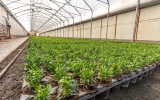How To Get A Farmers License (U.S.A. & U.K.)?
A farmer's license is an important document for anyone who plans to do farming, as it validates their right to do so. With the right training, knowledge, and paperwork, you can become a licensed farmer in both the United States and the United Kingdom. In this guide, we will discuss the steps you need to take to get your license.
In the U.S., farmers must obtain a license from the state Department of Agriculture, which typically involves completing an application, and additional paperwork. In the U.K., farmers need to register with the Rural Payments Agency, which requires them to provide proof of identity and agricultural qualifications.
Let’s get to know the requirements and benefits of a farming license. Here's a step-by-step, detailed process of how to get a farmer’s license to start your farming journey.
Summary
- To get a farmer's license in the U.S. or the U.K., applicants must meet certain criteria, which vary by region.
- In the U.S.A., this includes obtaining a business license, completing a farmer training program, and obtaining any necessary permits and certifications.
- In the U.K., applicants must register with the local authority, obtain a food safety certification, and adhere to various animal welfare regulations.

On this page:
7 Steps To Get A Farmer’s License in the U.S.A.
If you're looking to become a farmer in the United States, you'll need to obtain a farmer's license. This guide will walk you through the process step-by-step, from researching local laws to obtaining the necessary permits. With the right information and preparation, you'll be able to start your new farming career in no time.
1. Determine the type of farming license you need
In the United States, the type of farming license you need will depend on your state and what type of farming you plan on doing. Depending on the type of farming you will be doing, you may need a state or federal license. Each state has different regulations and requirements for licensing, so it is important to research your state's rules and regulations.
In some cases, you may also need to obtain a license from the U.S. Department of Agriculture’s Food Safety and Inspection Service (FSIS). The FSIS licenses and inspects businesses that slaughter, process, distribute, or sell meat and poultry products, and is responsible for ensuring the products meet food safety regulations.
2. Research the specific requirements for obtaining the license in your state
Requirements can vary from state to state, so make sure to check with your local Department of Agriculture or State Department of Licensing. It is important to research the specific requirements for your state, as the licensing requirements can vary significantly.
3. Gather the necessary documents and paperwork
You may need to provide proof of identity, proof of residence, proof of insurance, and other documents.
- Proof of Identity: Applicants for a farmer's license in the US must provide a valid form of government-issued photo identification, such as a driver's license, passport, or military ID.
- Proof of Residence: Applicants must also provide proof of their current address, such as a utility bill, bank statement, or tax return.
- Proof of Insurance: Applicants must provide proof of liability insurance coverage for their operations. This can be a copy of an insurance policy or a letter from the insurance company.
- Other Documents: Applicants may also be required to provide additional documents such as a business license, zoning permit, or proof of worker's compensation coverage.
4. Submit your application and any necessary fees
After submitting your application, you will need to wait for it to be processed and approved. The cost of a farmer's license varies by state but generally ranges from $20 to $50. In some states, additional fees may be required, such as a pesticide application fee or a sales tax.

5. Attend any required training
Depending on the type of license, you may need to attend a training course or seminar to become certified. Depending on the state, the specific courses required may vary. Generally, the following courses are required:
- Agricultural Production Practices
- Agricultural Business Management
- Farm Safety
- Pesticide Application
- Animal Husbandry
- Feed and Nutrition
- Equipment and Machinery Maintenance
- Agricultural Laws and Regulations
6. Take the licensing exam
Once you have completed the training, you will need to take and pass the licensing exam to receive your license. The licensing exam for getting a farmer's license in the USA varies from state to state but generally requires applicants to demonstrate knowledge of soil conservation, crop production, livestock management, agricultural business, and safety practices.
Depending on the state, the exam may have both a written and a practical component.
7. Receive your license
After passing the exam, your license will be sent to you by mail. Once you have obtained the appropriate licenses, you will be able to legally operate your farm.
8 Steps To Get A Farmer’s License in the UK
If you are looking to become a farmer in the UK, this step-by-step guide will give you the information you need to get a farmer's license. We'll cover the different steps involved and what you should expect to do, so you can get the license you need to start farming.
1. Contact your local government authority to determine whether you need a license to farm in your area
Contact your local government authority to find out the specific regulations and laws regarding farming in your area. Determine whether the type of farming you are wanting to do requires a license, and if so, what type and from which authority you need to get it. Ask about any other licenses you may need, such as those for selling products or transporting animals.
2. Research the specific requirements and regulations for getting a farmer's license in the UK
- Farmers must be at least 18 years old and have a valid driver's license.
- Farmers must have a valid certificate of competence in agricultural practices.
- Farmers must have detailed knowledge of the health and safety regulations and laws governing the production and sale of agricultural products.
- Farmers must have the necessary insurance to cover any potential losses or liabilities resulting from their farming activities.
- Farmers must have the necessary equipment and facilities to maintain the safety and quality of the agricultural products they produce.
3. Collect all necessary documents such as proof of identity, proof of address, and proof of business registration
Details of the nature and extent of the farming activity to be undertaken
- Proof of identity: valid UK passport, full UK driving license, valid UK biometric residence permit
- Proof of address: utility bill (not more than 3 months old), bank statement (not more than 3 months old), local authority tax bill
- Proof of business registration: company registration certificate, partnership registration certificate (if applicable), certificate of incorporation (if applicable)
4. Fill out the application form for a farmer's license and submit it along with all the required documents
The application form to obtain a farmer’s license in the UK requires applicants to provide detailed personal and business information. This includes:
- Name, address, and contact details
- Business name, type of business, and address of the holding
- Confirmation that the applicant has received all necessary government authorizations
- Details of the nature and extent of the farming activity to be undertaken
- Evidence of the applicant’s financial suitability
5. Pay the farmer's license fee
The cost of a farmer's license in the UK depends on the size of the land and the type of activities being carried out on the land. For example, a smallholding of up to two hectares requires an annual fee of £30, while a larger farm of over two hectares requires a fee of £90 per year.

6. Attend an interview with the local licensing authority and provide additional information they may require
The interview with the local licensing authority to get a farmer’s license in the UK should include the following information:
- The applicant’s farming background and experience
- The type of farming they plan to pursue
- The type of crops they plan to grow
- The type of livestock they plan to raise
- The type of farming equipment they plan to use
- The applicant’s plans for marketing their products
7. Wait for the licensing authority to process your application and approve or deny your request
The time it takes for the licensing authority to process and approve or deny your application for a farmer's license in the UK can vary significantly depending on the complexity of the application and the current workload of the licensing authority.
Generally, the licensing authority should aim to process the application within 28 days; however, in some cases, due to the complexity of the application or the current workload, this may take longer. It is important to contact the licensing authority to check the status of the application if it has been more than 28 days since its submission.
8. If approved, receive your farmer's license and start farming
Once approved, you can obtain a farmer's license from your local Rural Payments Agency (RPA) office. Your local RPA office can provide you with the necessary paperwork to apply for a farmer's license, as well as provide guidance and advice on the application process.
Once approved, the farmer's license will be valid for five years and will allow you to access certain agricultural subsidies and grants. You may also be required to pay an annual fee to keep your license valid.


